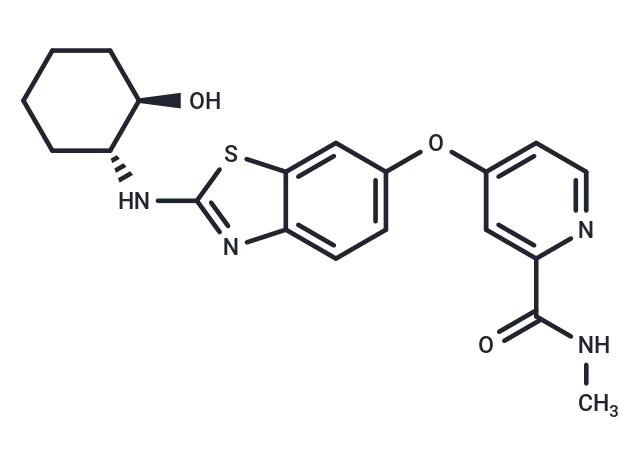Shopping Cart
- Remove All
 Your shopping cart is currently empty
Your shopping cart is currently empty

Sotuletinib (BLZ945) is an orally active, effective and specific CSF-1R inhibitor (IC50: 1 nM), >1000-fold selective against its closest receptor tyrosine kinase homologs.

| Pack Size | Price | Availability | Quantity |
|---|---|---|---|
| 1 mg | $31 | In Stock | |
| 5 mg | $72 | In Stock | |
| 10 mg | $113 | In Stock | |
| 25 mg | $175 | In Stock | |
| 50 mg | $228 | In Stock | |
| 100 mg | $397 | In Stock | |
| 500 mg | $913 | In Stock | |
| 1 mL x 10 mM (in DMSO) | $79 | In Stock |
| Description | Sotuletinib (BLZ945) is an orally active, effective and specific CSF-1R inhibitor (IC50: 1 nM), >1000-fold selective against its closest receptor tyrosine kinase homologs. |
| Targets&IC50 | CSF1R:1 nM |
| In vitro | In bone marrow-derived macrophages (BMDMs), Sotuletinib specifically inhibits CSF-1-dependent proliferation with EC50 of 67 nM, and decreases CSF-1R phosphorylation. Sotuletinib blocks the reciprocal effects between macrophages and glioma cells on the survival, proliferation and/ or polarization of each other to promote tumorigenesis. [1] |
| In vivo | In glioma-bearing mice, Sotuletinib blocks tumor progression and significantly improves survival via CSF-1R inhibition. Sotuletinib also inhibits orthotopic tumor growth of patient-derived proneural tumor spheres and cell lines in vivo. [1] Sotuletinib (200 mg/kg, p.o.) decreases the growth of malignant cells in both mouse mammary tumor virus-driven polyomavirus middle T antigen (MMTV-PyMT) model of mammary carcinogenesis and keratin 14-expressing human papillomavirus type 16 (K14-HPV-16) transgenic model of cervical carcinogenesis. [2] |
| Kinase Assay | Inhibition of biochemical TrkA, TrkB and TrkC: TrkA and TrkC biochemical assays are carried out by HTRF method. The reaction mixtures contains 1 μM peptide substrate, 1 μM ATP, and either 1.8 nM TrkA or 34 nM TrkC in the reaction buffer (50 mM HEPES pH 7.1, 10 mM MgCl2, 2 mM MnCl2, 0.01% BSA, 2.5 mM DTT and 0.1 mM Na3VO4) at a final volume of 10 μL. All reactions are carried out at room temperature in white ProxiPlate? 384-well Plus plates and are quenched with 5 μL of 0.2 mM EDTA at 60 min. Five μL of the detection reagents (2.5 ng PT66K and 0.05 μg SAXL per well) are added, the plates are incubated at room temperature for 1 h and then read in EnVision reader. Compounds are diluted into assay mixture (final DMSO 0.5%), and IC50 values are determined by 12-point (from 50 to 0.000282 μΜ) inhibition curves in duplicate under the assay conditions. TrkB biochemical assay is carried out by caliper microfluidic method. The reaction mixtures contained 1 μM peptide substrate, 10 μM ATP, and 2 nM TrkB in a reaction buffer containing 100 mM HEPES, pH 7.5, 5 mM MgCl2, 0.01% Triton X-100, 0.1% BSA, 1 mM DTT, 10 μΜNa3VO4, and 10 μΜBeta-Glycerophosphate. The reactions are carried out at room temperature for 3 hrs, and the products are determined by Caliper EZ-reader. Compounds are diluted into assay mixture (final DMSO 1%), and IC50 values are determined by 12-point (from 50 to 0.000282 μΜ) inhibition curves in duplicate under the assay conditions. |
| Cell Research | Cell growth rate is determined using the MTT cell proliferation kit. Briefly, cells are plated in triplicate in 96-well plates: 1,000 cells per well for glioma cell lines, 5 x 1,000 cells per well for BMDM and CRL-2467, and 2.5 x 1,000 cells per well for HUVEC and HBMEC cell lines. For all experiments, media is changed every 48 h. Cells are grown in the presence or absence of 6.7–6,700 nM of BLZ945, or 8 μg/mL of CSF-1R neutralizing antibody. BMDM and CRL-2467 cells were supplemented with 10 ng/mL and 30 ng/ mL recombinant mouse CSF-1, respectively. Reduction of the MTT substrate is detected by colorimetric analysis using a plate reader as per the manufacturer's protocol, and measured at 595 nm and 750 nm on a spectraMax 340pc plate reader.(Only for Reference) |
| Alias | BLZ945 |
| Molecular Weight | 398.48 |
| Formula | C20H22N4O3S |
| Cas No. | 953769-46-5 |
| Smiles | CNC(=O)c1cc(Oc2ccc3nc(N[C@@H]4CCCC[C@H]4O)sc3c2)ccn1 |
| Relative Density. | 1.377 g/cm3 (Predicted) |
| Storage | keep away from direct sunlight,keep away from moisture,store at low temperature | Powder: -20°C for 3 years | In solvent: -80°C for 1 year | Shipping with blue ice. | ||||||||||||||||||||||||||||||
| Solubility Information | DMSO: 18.33 mg/mL (46.01 mM), Sonication is recommended. Ethanol: 3 mg/mL (7.52 mM), Heating is recommended. H2O: < 1 mg/mL (insoluble or slightly soluble) | ||||||||||||||||||||||||||||||
Solution Preparation Table | |||||||||||||||||||||||||||||||
Ethanol/DMSO
DMSO
| |||||||||||||||||||||||||||||||

Copyright © 2015-2025 TargetMol Chemicals Inc. All Rights Reserved.